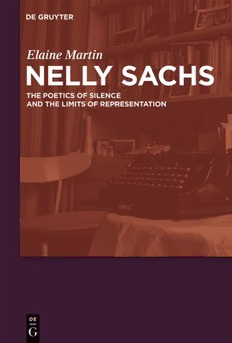
Nelly Sachs: The Poetics of Silence and the Limits of Representation PDF
Preview Nelly Sachs: The Poetics of Silence and the Limits of Representation
Elaine Martin Nelly Sachs Elaine Martin Nelly Sachs The Poetics of Silence and the Limits of Representation De Gruyter ISBN 978-3-11-025672-7 e-ISBN 978-3-11-025673-4 LibraryofCongressCataloging-in-PublicationData Martin,Elaine,1982− Nelly Sachs : the poetics of silenceand the limits of represen- tation/byElaineMartin. p.cm. Includesbibliographicalreferences. ISBN978-3-11-025672-7(acid-freepaper) 1.Sachs,Nelly−Criticismandinterpretation. I.Title. PT2637.A4184Z719 2011 8311.914−dc23 2011016184 BibliographicinformationpublishedbytheDeutscheNationalbibliothek TheDeutscheNationalbibliothekliststhispublicationintheDeutsche Nationalbibliografie;detailedbibliographicdataareavailableintheInternet athttp://dnb.d-nb.de. ©2011WalterdeGruyterGmbH&Co.KG,Berlin/Boston Coverillustration:DetailofNellySachs’apartmentatBergsundsstrand23,Stockholm. ©NationalLibraryofSweden,MSL90:8:11.PhotographerHarryJärv. Printingandbinding:Hubert&Co.GmbH&Co.KG,Göttingen (cid:2)Printedonacid-freepaper PrintedinGermany www.degruyter.com Acknowledgements IoweaparticulardebtofgratitudetoProfessorFlorianKrobb,whoseen- couragement and enthusiasm helped me towards the completion of this book, and whose depth of knowledge has been and continues to be an invaluable resource. Thanks also to Professor Karen Leeder of New Col- lege, Oxford, whose input was greatly appreciated, and to Dr. Jeff Mor- rison, whose constructive feedback made the book a more pleasant read. Furthermore, I wish to extend a word of gratitude to all members of the German Department at National University of Ireland Maynooth for their collegiality during the past number of years. Without the financial assistance made possible by the Irish Research Council for the Humanities and Social Sciences and the John and Pat Hume Scholarship from NUI Maynooth, this project would not have come to fruition. My thanks therefore to these two bodies for funding the doctoral dissertation from which this book evolved. Additionally, the book’s publication was financed by publication grants from the Na- tional University of Ireland and National University of Ireland May- nooth. My thanks to both institutions for trusting in the merit of the book. I am also grateful to the Suhrkamp Verlag for its generous permis- sion to reprint poems from the following volumes: Fahrt ins Staublose. Die Gedichte der Nelly Sachs (Frankfurt am Main: Suhrkamp, 1961), Suche nach Lebenden. Die Gedichte der Nelly Sachs (Frankfurt am Main: Suhrkamp, 1971) and Nelly Sachs Werke. Kommentierte Ausgabe Band1. Gedichte1940–1950(FrankfurtamMain:Suhrkamp,2010).Articlesre- latedtopartsofchapterstwoandthreeof thisbookhaveappearedinthe followingvolumes:GertHofmann,MarkoPajevic,RachelMagShamrain and Michael Shields (eds.) German and European Poetics after the Holo- caust: Crisis and Creativity (Rochester/New York: Camden House, 2011) and Alfred J. Drake (ed.) New Essays on the Frankfurt School of Critical Theory (Newcastle-upon-Tyne: Cambridge Scholars Publishing, 2009). I must also mention close friends who never forgot to ask how it was going. A special word of thanks goes to Anne Marie, Suzanne and John, allof whomgenerouslygavetheirtimetoproofreadingthemanuscriptat various stages. VI Acknowledgements Themost important wordof thanksgoes tomyparents, who contin- ually supported and encouraged me, and to Conleth for having been and continuing to be so supportive in ways too numerous to mention. Sadly, my mother is no longer here to see the final product. This book is dedi- cated to her. Contents Introduction .......................................... 1 I Contexts 1 Nelly Sachs: A Tumultuous Reception History ............. 9 1.1 West Germany’s Three Myths ...................... 9 1.2 Peace with The Perpetrators ....................... 18 1.3 Restoration in the Literary Arena ................... 24 1.4 Reception in the East ............................ 27 1.5 Reception in the West: “Die Dichterin der Versçhnung” 33 2 The Problematics of Holocaust Representation ............. 49 2.1 Adorno’s ‘after-Auschwitz’ Aporia ................... 49 2.2 The Expropriation of Death and Adorno’s Modernist Critique ....................................... 55 2.3 ‘The Extremity that Eludes the Concept’ ............. 57 2.4 The Failure of Culture ........................... 61 2.5 Adorno’s ‘Widerruf’ ............................. 63 II Practices 3 Nelly Sachs’ Poetics of Silence: Poetry at the Limits of Representation ...................................... 69 3.1 Defying ‘Verstummen’ ........................... 69 3.2 The Decay of Language .......................... 71 3.3 Addressing the Perpetrators ........................ 83 3.4 Prosopopoeia as a Representational Device ............ 98 3.5 Sachs’ Nacht-Metaphorik: Reversing a Traditional Image 105 3.6 The Poetics of Disfiguration ....................... 113 3.7 Adorno’s Extremity in Sachs’ Poetics ................ 122 3.8 Writing the Inability to Write: Sachs’ Self-Reflective Poetics 125 3.9 ‘Grabschriften in die Luft’: Keeping Memory Open .... 131 3.9.1 The Open Wound ........................ 137 VIII Contents 3.10 The ‘Death of Death’: ‘Die Todentrissenen’ ........... 140 3.11 Archetypes as Representational Devices .............. 150 3.11.1 Sachs’ ‘Anti-Job’ .......................... 152 3.11.2 Abraham: Refuting the Martyrdom Thesis ...... 167 3.11.3 Daniel: Interpreter of Nightmares ............ 179 Conclusion ........................................... 183 Bibliography .......................................... 187 Introduction Thepositivereceptionof NellySachs’poetryinthelate1950sand1960s culminated in Sachs being awarded the Nobel Prize for Literature in 1966,jointlywiththeIsraeliauthorSamuelJ.Agnon.Virtuallyunknown duringthepreviousdecade,SachswassuddenlyhailedasWestGermany’s “Dichterin der Versçhnung”: she and her work became symbols of Ger- man-Jewish reconciliation in an era preoccupied with Vergangenheitsbe- w(cid:2)ltigung – the attempt to critically address the legacy of the National Socialist past. A close examination of how Sachs’ poetry was received in West and East Germany, and of the socio-political factors which led to her person and her work becoming icons of German-Jewish reconcili- ation in the Federal Republic, sheds a fascinating light on the social and psychological trends that dominated the post-war German landscape. The manner in which literary works are received in the public domain is, of course, inextricably linked with the prevailing socio-political condi- tions. Topics, Raul Hilberg writes, “may be suppressed or catapulted to public attention, but always for reasons that reflect the problems and needs of asociety”(Hilberg 1996:123). Correspondingly –so theprem- ise of the first section of this study – the socio-political conditions of the post-warperiodrevealwhythetablesturnedwithrespecttothereception of Sachs’work in the East and in theWest as the eventsof the Holocaust receded in time. The initial disregard for Sachs in the Federal Republic, followed by the sudden discovery and ensuing appropriation of her per- son and work a decade later on the one hand, and the initial reception of andsubsequentdisregardforherworkinEastGermanyontheother,can be attributed to the socio-political concerns of the day. The focus is then shifted to the ‘unspeakability’ maxim associated withTheodorAdorno,whosepositiononpost-Shoahartsopressinglyre- quires a re-examination. The debate on what has mistakenly come to be known as Adorno’s ‘dictum’ concerning the ‘barbarity of poetry after Auschwitz’ – “nach Auschwitz ein Gedicht zu schreiben ist barbarisch” (Adorno 1977: 30) – dominated academic discussion in the decades fol- lowing its publication in 1951. This debate serves as an effective spring- board from which to evaluate Nelly Sachs’ Holocaust poetry given that the aporetics of Holocaust art identified by Adorno, namely, the impos-
